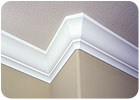
If historical building trends play out the rest of 2006 and into 2007, the remodeling sector should boom and bring with it a flurry of new activity for the drywall industry. Despite higher energy costs and rising interest rates, homeowners are still expected to makeover their homes with projects ranging from room additions to kitchen remodels.
As such, the long-term outlook for home improvement products, which includes jobs contracted to professionals and do-it-yourself projects, is expected to hit $312 billion in 2006 and rise to $319 billion in 2007, according to the Home Improvement Research Institute.
This article will discuss a few of the reasons behind the expected growth in remodeling.

Home sales driving growth
The optimistic outlook for remodeling in 2007 is due in part to the record year for existing home sales in 2005, which reached an all-time high of 7.072 million units, according to the National Association of Realtors. Most housing experts agree that remodeling spending usually lags 12 to 18 months behind home sales, which means a good number of 2005's home buyers are getting ready to commit to remodeling projects."Remodeling is less volatile than new home construction, partly because nearly half of all expenditures represent non-discretionary maintenance and repair projects," National Association of Home Builders Chief Economist Dave Seiders says in August. "The average age of the housing stock is 32 years and rising-well past the time when major home systems need replacement. Supported by $11 trillion in homeowner equity, the fundamentals of the remodeling market will remain strong for the foreseeable future."
While most forecasts point toward a cooling in the new housing market, remodeling seems to be right on track.
"We expect lower demand (for new homes) as the overall housing market slows," says Vince Butler, chairman of the NAHB's Remodelors Council. "However, the remodeling market should perform relatively well."
Baby boomers leading the way
The baby boom generation, all 78 million of them, is fueling much of the growth in the remodeling sector as homeowners more than 60 years old ready their houses for their future needs. According to the NAHB's Remodeling Market Index, which surveys professional remodelers quarterly, baby boomers account for the vast majority of remodeling work, with 91 percent of remodelers providing services to this age group.As older Americans embrace home ownership more than ever before, a top concern is how they can stay in those homes comfortably while maintaining their active lifestyle as they age. Half of baby boomers surveyed by Yankelovich, a leading lifestyle research company, says they plan on staying in their current homes during their retirement years and beyond.
"As the population continues to age, Aging-in-Place remodeling will continue to be needed," says Kieren Corcoran, national product manager, Georgia-Pacific Corp.
Of remodeling companies surveyed in the RMI's second quarter survey, 60 percent modify homes for aging-in-place needs and 75 percent say their clients were planning ahead for future needs.
Baby boomers are also passing the remodeling torch to the next generation, Generation X, which is expected to keep the remodeling fires burning bright in the years to come. According to Harvard's Joint Center for Housing Studies, Generation X, whose members are heading into the prime remodeling age of 35 to 45 years, spend more on home remodeling than baby boomers did at their age-a good sign for the remodeling trades the rest of this decade.
All this adds up to a steady flow of remodeling jobs as homes transition from one generation to the next and as the massive baby boom generation begins its aging-in-place progress.

Kitchens still top the list
Kitchens and baths continue to be the most popular rooms in the house to remodel, according to the NAHB. The U.S. Census Bureau reports spending on kitchen renovations more than tripled between 2000 and 2005, and was expected to climb another 25 percent in 2006, according to Kitchen and Bath Business magazine's Market Forecaster report.While new homebuilders may be concerned about a market slowing, remodelers can breathe a sigh of relief after seeing these figures.
"According to recent research, remodelers have the most positive economic outlook of four sectors tested," says Greg Wolf, director of marketing for Fypon, a manufacturer of urethane molding products. "Fifty-nine percent of the respondents expect a better outlook and 28 percent believe it will remain the same. Permits for remodeling show sizeable growth with many of the fastest growing areas along the East Coast. Among the top 25 metro areas, only Detroit and Atlanta showed a decrease in permits for remodeling."

Gypsum consumption on the rise
As the housing sector thrived the past five years, gypsum consumption also reached new heights. Gypsum Association statistics show that gypsum shipments in the United States steadily rose each of the past five years and reached an all-time high in 2005 of 36.16 billion square feet of material. Through the first half of 2006, gypsum shipments were roughly 1.3 billion square feet ahead of 2005 year-to-date figures.So what does this mean for 2007? Most industry insiders believe next year will be another banner year for gypsum shipments.
"The gypsum industry has forecast the repair/remodel segment to surge in 2007," says Bill Scannell, president of Structus Building Technologies, a supplier of drywall related products. "Lending rates are still relatively low and with diminished consumer confidence, people will more likely remodel than relocate. Our products are great for minimizing drywall sanding, which is a considerable challenge in residential remodel, so we expect to benefit from this trend."
Is growth on the way?
While the remodeling forecast remains bright for 2007, the real question is how much will the anticipated slowdown in new housing damper overall business growth in the drywall market?"Residential contractors who have enjoyed the boom of the past 14 years will have to become more competitive in the tightened housing market," says Scannell. "We're likely to see contractors use value-added products and selling techniques coupled with more competitive bidding. The commercial segment will continue to enjoy good growth as a lagging function of the residential building of recent years."
Georgia-Pacific's Corcoran also sees builders needing to stand out from others to stay competitive in the marketplace.
"I expect remodel to have moderate growth in the near future," says Corcoran. "However, there will be less work for more firms, which means more than ever remodelers will need to differentiate themselves. One method is through education and designation programs. The National Home Builders Association's Remodelers Council is one group that offers programs. And, through the Certified Graduate Remodeler and the Certified Aging-In-Place Specialist, remodelers are able to differentiate themselves and promote professionalism in the industry."
Corcoran also notes that green building will continue to impact building practices, which will continue to affect the drywall industry positively.
As for overall growth, Fypon's Wolf anticipates a rather even year in 2007.
"With the decline of new construction at about 8 percent that would offset any gains drywall might experience in the remodeling segment."

Report Abusive Comment